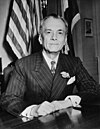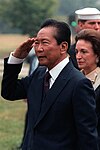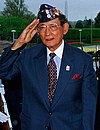List of presidents of the Philippines: Difference between revisions
i added picture |
|||
| Line 57: | Line 57: | ||
| 9 ||style="background:#f0e68c"| || [[Diosdado Macapagal]] || December 30, 1961 || December 30, 1965 || [[Liberal Party (Philippines)|Liberal]] || [[Emmanuel Pelaez]] || [[Philippine general election, 1961|7]] |
| 9 ||style="background:#f0e68c"| || [[Diosdado Macapagal]] || December 30, 1961 || December 30, 1965 || [[Liberal Party (Philippines)|Liberal]] || [[Emmanuel Pelaez]] || [[Philippine general election, 1961|7]] |
||
|- align=center |
|- align=center |
||
| rowspan=5|10 ||rowspan=2 style="background:#98fb98"| || rowspan=5| [[Ferdinand Marcos]] [[Image:Marcos |
| rowspan=5|10 ||rowspan=2 style="background:#98fb98"| || rowspan=5| [[Ferdinand Marcos]] [[Image:Ferdinand Marcos.JPEG|100px]] || rowspan=5| December 30, 1965 || rowspan=5|February 25, 1986<ref group="L">Deposed in the 1986 [[People Power Revolution]].</ref> || rowspan=2| [[Nacionalista Party (Philippines)|Nacionalista]] || rowspan=2| [[Fernando Lopez]] || [[Philippine general election, 1965|8]] |
||
|- align=center |
|- align=center |
||
| [[Philippine general election, 1969|9]] |
| [[Philippine general election, 1969|9]] |
||
Revision as of 11:06, 25 November 2009
The President of the Philippines is the head of state governing the country. According to the Philippine government, the office has been held by politicians who were inaugurated as President of the Philippines following the ratification of a constitution that explicitly declared the existence of the Philippines.
For leaders of the Philippines prior to the arrival of the Spaniards, see Datu. For leaders prior to the ratification of the 1899 constitution, see Royal Governor of the Philippines. For leaders prior to the ratification of the 1935 constitution, see Governor-General of the Philippines.
The King of Spain was the head of state during the Spanish era (1565–1898) and the President of the United States was the head of state during the American era (1898–1946). Note that the presidents under the Commonwealth of the Philippines were under United States sovereignty, and that the president of the Second Republic is considered to have been running a puppet government of the Japanese during World War II although this puppet government of Jose P. Laurel during the Japanese occupation was officially considered independent by the Japanese. Thus the Philippines had three Presidents during that war - one de facto and two de jure, and two at the same time.[1]
Emilio Aguinaldo's government wasn't officially recognized by the Philippine government until the term of Diosdado Macapagal.[2]
Legend
The colors in the following chart indicate the political party or coalition of each President at Election Day or at the time of ascendence.
List of Presidents
| # | President | Took office | Left office | Party | Prime Minister | Vice President | Term | Era | |
|---|---|---|---|---|---|---|---|---|---|
| 1 | Emilio Aguinaldo  |
January 23, 1899[L 1] | April 1, 1901[L 2] | none (Formerly Katipunan,[L 3] Magdalo faction) |
Apolinario Mabini Pedro Paterno |
none (The 1899 Constitution did not provide for a Vice President) |
- | First Republic (Malolos Republic) | |
| Abolished Due to the leadership of the Governors of the Philippine Islands from April 1, 1901 to November 15, 1935. | |||||||||
| 2 | Manuel L. Quezon  |
November 15, 1935 | August 1, 1944[L 4] | Nacionalista | none (The 1935 Constitution did not provide for a Prime Minister) |
Sergio Osmeña | 1 | Commonwealth | |
| 2 | |||||||||
| 3 | José P. Laurel | October 14, 1943 | August 17, 1945[L 5] | KALIBAPI[L 6] (Caretaker government under Japanese occupation) |
none (The 1943 Constitution did not provide for a Prime Minister) |
Benigno Aquino Sr.[3] Ramon Avancena[3] |
- | Second Republic | |
| 4 | Sergio Osmeña | August 1, 1944 | May 28, 1946 | Nacionalista | none (The 1935 Constitution did not provide for a Prime Minister) |
vacant | 2 | Commonwealth (Restored) | |
| 5 | Manuel Roxas | May 28, 1946 | April 15, 1948[L 7] | Liberal | Elpidio Quirino | 3 | |||
| Third Republic | |||||||||
| 6 | Elpidio Quirino  |
April 17, 1948 | December 30, 1953 | vacant | |||||
| Fernando Lopez | 4 | ||||||||
| 7 | Ramon Magsaysay | December 30, 1953 | March 17, 1957[L 8] | Nacionalista | Carlos P. Garcia | 5 | |||
| 8 | Carlos P. Garcia | March 18, 1957 | December 30, 1961 | vacant | |||||
| Diosdado Macapagal | 6 | ||||||||
| 9 | Diosdado Macapagal | December 30, 1961 | December 30, 1965 | Liberal | Emmanuel Pelaez | 7 | |||
| 10 | Ferdinand Marcos  |
December 30, 1965 | February 25, 1986[L 9] | Nacionalista | Fernando Lopez | 8 | |||
| 9 | |||||||||
| Kilusang Bagong Lipunan | Ferdinand Marcos | vacant | 10 | Second Dictatorship "The New Society" | |||||
| 11 | Fourth Republic | ||||||||
| Cesar Virata | Arturo Tolentino | 12 | |||||||
| 11 | Corazon Aquino  |
February 25, 1986[L 10] | June 30, 1992 | UNIDO | Salvador Laurel | Salvador Laurel | |||
| Fifth Republic | |||||||||
| none (The 1987 Constitution did not provide for a Prime Minister) | |||||||||
| 12 | Fidel V. Ramos  |
June 30, 1992 | June 30, 1998 | Lakas–NUCD–UMDP | Joseph E. Estrada | 13 | |||
| 13 | Joseph Estrada  |
June 30, 1998 | January 20, 2001[L 11] | LAMMP (Under Laban ng Makabayang Masang Pilipino coalition) |
Gloria Macapagal-Arroyo | 14 | |||
| 14 | Gloria Macapagal-Arroyo  |
January 20, 2001 | incumbent (Term ends June 30, 2010) |
Lakas–CMD/KAMPI | vacant | ||||
| Teofisto Guingona | |||||||||
| Lakas–CMD/KAMPI (Under Koalisyon ng Katapatan at Karanasan sa Kinabukasan coalition) |
Noli de Castro | 15 | |||||||
Notes
- ^ Term began with the inauguration of the Malolos Republic, considered the First Philippine Republic.
- ^ Term ended when Aguinaldo pledged allegiance to the United States after his capture at Palanan, Isabela.
- ^ Founded by Andrés Bonifacio and others on July 7, 1892; converted into a revolutionary government by Bonifacio on August 24, 1986; as a government, officially replaced by the Tejeros revolutionary government on March 22, 1897 - though some sectors refused cooperation; as an organization, officially abolished by Emilio Aguinaldo on July 15, 1898
- ^ Died due to tuberculosis at Saranac Lake, New York.
- ^ Term ended with his dissolving the Philippine Republic in the wake of the surrender of Japanese forces to the Americans at World War II.
- ^ Originally a Nacionalista, but was elected by the National Assembly under Japanese control. All parties were merged under Japanese auspices to form Kalibapi, to which all officials belonged.
- ^ Died due to a heart attack at Clark Air Base.
- ^ Died on a plane crash at Mount Manunggal, Cebu.
- ^ Deposed in the 1986 People Power Revolution.
- ^ Assumed presidency by claiming victory in the disputed 1986 snap election.
- ^ Deposed after the Supreme Court declared Estrada as resigned, and the office of the presidency as vacant as a result, after the 2001 EDSA Revolution.
Statistics
- Vice Presidents who succeeded to the Presidency
- Sergio Osmeña (1944)
- Elpidio Quirino (1948)
- Carlos P. Garcia (1957)
- Diosdado Macapagal (1961)
- Joseph E. Estrada (1998)
- Gloria Macapagal-Arroyo (2001)
- Presidents who have been re-elected
- Manuel L. Quezon (1941)
- Ferdinand Marcos (1969, 1981)
- Presidents who were elected when serving the remaining term of predecessor
- Elpidio Quirino (1949)
- Carlos P. Garcia (1957)
- Gloria Macapagal-Arroyo (2001)
- Longest serving President: Ferdinand Marcos, 7,362 days
- Shortest serving President: Sergio Osmeña, 479 days
Unofficial presidencies
Historians and other figures have identified the following people as having held the presidency of a government intended to represent the Philippines, but their terms of office are not counted by the Philippine government as part of the presidential succession.
| # | President | Took office | Left office | Party | Prime Minister | Vice President | Term | Era | |
|---|---|---|---|---|---|---|---|---|---|
| A | Andres Bonifacio [4][5][6][7] |
August 24, 1896[L 1] | March 22, 1897[L 2] or May 10, 1897[L 3] |
Katipunan | none (The Tagalog Republic did not provide for a Prime Minister) |
none (The Tagalog Republic did not provide for a Vice President) |
- | Tagalog Republic (Bonifacio) | |
| B | Emilio Aguinaldo | March 22, 1897[L 4] | November 1, 1897[L 5] | Katipunan - later abolished (Magdalo faction) |
none (The Tejeros Convention did not provide for a Prime Minister) |
Mariano Trias | - | Tejeros revolutionary government | |
| B | Emilio Aguinaldo | November 2, 1897[L 6] | December 15, 1897[L 7] | Katipunan - later abolished (Magdalo faction) |
none (The Republic of Biak-na-Bato did not provide for a Prime Minister) |
Mariano Trias | - | Republic of Biak-na-Bato | |
| B | Emilio Aguinaldo | May 24, 1898[L 8] | June 23, 1898[L 9] | Katipunan - later abolished (Magdalo faction) |
Apolinario Mabini | none (The dictatorial government did not provide for a Vice President) |
- | First Dictatorship | |
| B | Emilio Aguinaldo | June 23, 1898[L 10] | January 23, 1899[L 11] | Katipunan - later abolished (Magdalo faction) |
Apolinario Mabini | none (The revolutionary government did not provide for a Vice President) |
- | Pre-Malolos revolutionary government | |
| C | Miguel Malvar [8] |
April 1, 1901[L 12] | April 16, 1902[L 13] | none (Formerly Katipunan) |
none | none (The 1899 Constitution did not provide for a Vice President) |
- | First Republic (Malolos Republic) | |
| D | Macario Sakay [9][10][11] |
May 6, 1902[L 14] | July 14, 1906[L 15] | none (Formerly Katipunan) |
none (The Tagalog Republic did not provide for a Prime Minister) |
Francisco Carreón | - | Tagalog Republic (Sakay) | |
Notes
- ^ Term began when Bonifacio declared the establishment of the Tagalog Republic.
- ^ Term ended after the Tejeros Convention.
- ^ Executed for treason by Aguinaldo's government; Bonifacio did not recognize its validity and still acted as president.
- ^ Term was established at the Tejeros Convention; Aguinaldo took his oath of office the day after (March 23), but did not fully assume the office until late April 1897.
- ^ Term ended with the establishment of the Republic of Biak-na-Bato.
- ^ Term began after the establishment of the Republic of Biak-na-Bato.
- ^ Term ended when Aguinaldo signed the Pact of Biak-na-Bato.
- ^ Term began when Aguinaldo declared a dictatorial government of the Philippines.[dead link]
- ^ Term ended with the declaration of a revolutionary government replacing the dictatorship.[dead link]
- ^ Term began with the declaration of a revolutionary government replacing the dictatorship.[dead link]
- ^ Term ended with the inauguration of the Malolos Republic, considered the First Philippine Republic.
- ^ Term began when Malvar assumed the presidency after the capture of Aguinaldo.
- ^ Term ended when Malvar surrendered in Batangas.
- ^ Term began when Sakay declared the establishment of the Tagalog Republic (in the tradition of Bonifacio instead of Aguinaldo).
- ^ Term ended when Sakay surrendered as part of an amnesty; he was executed a year later.
References
- ^ Quezon III, Manuel (February 2, 2001). "For trivia freaks". Today.
{{cite news}}: Cite has empty unknown parameter:|coauthors=(help) - ^ Proclamation No. 28 Declaring June 12 as Philippine Independence Day. (1962-5-12). Retrieved 2009-10-25.
- ^ a b Philippine Presidents & Vice-Presidents List
- ^ Guererro, Milagros; Encarnacion, Emmanuel; Villegas, Ramon (1996). "Andres Bonifacio and the 1896 Revolution". Sulyap Kultura. 1 (2). National Commission for Culture and the Arts: 3–12.
- ^ Guererro, Milagros; Schumacher, S.J., John (1998). Reform and Revolution. Kasaysayan: The History of the Filipino People. Vol. 5. Asia Publishing Company Limited. ISBN 962-258-228-1.
- ^ Borromeo-Buehler, Soledad M. (1998), The Cry of Balintawak: a contrived controversy, Quezon City: Ateneo de Manila University Press, ISBN 971-5502-78-4
- ^ Severino, Howie (2007-11-27). "Bonifacio for (first) president". gmanews.tv. GMA Network. Retrieved 2009-08-20.
- ^ Cruz, Maricel V. (2008-02-02). "Lawmaker: History wrong on Gen. Malvar". www.manilatimes.net. Manila Times. Retrieved 2009-08-20.
- ^ Agoncillo, Teodoro (1990) [1960], History of the Filipino People (8th ed.), Quezon City: Garotech Publishing Inc., ISBN 971-1024-15-2
- ^ Flores, Paul (1995-08-12). "Macario Sakay: Tulisán or Patriot?". Philippine History Group of Los Angeles. Retrieved 2007-04-08.
- ^ Tan, Michael (2007-09-21). "September's heroes". www.inquirer.net. Philippine Daily Inquirer. Retrieved 2009-08-20.
See also
- President of the Philippines
- Vice President of the Philippines
- List of Vice Presidents of the Philippines
- Prime Minister of the Philippines (presently defunct)
- Seal of the President of the Philippines
External links
- Office of the President of the Philippines
- Philippine Heads of State Timeline at www.worldstatesmen.org
- The Philippine Presidency Project
